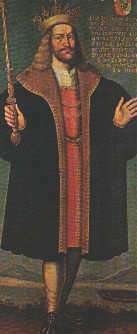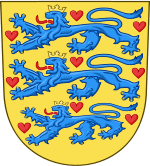Eric IV of Denmark
Eric IV, also known as Eric Ploughpenny or Eric Plowpenny (Danish: Erik Plovpenning), (c. 1216 – 10 August 1250) was king of Denmark from 1241 until his death in 1250. He was the son of King Valdemar II by his wife, Berengaria of Portugal, and brother of King Abel and King Christopher I.
Early life

Eric was born in 1216 as the second legitimate son of King Valdemar II by his second wife Berengária of Portugal. In 1218, when his older half-brother Valdemar was crowned king as their father's co-ruler and designated heir, he was created Duke of Schleswig. After the premature death of Valdemar in 1231, Eric in his turn was crowned king at Lund Cathedral 30 May 1232 as his father's coruler and heir. Subsequently, he ceded the Duchy of Schleswig to his younger brother Abel. When his father died in 1241, he automatically acceded to the throne.
Rule
His rule was marked by bitter conflicts and civil wars against his brothers. Especially he fought his brother, Duke Abel of Schleswig who seems to have wanted an independent position and who was supported by the counts of Holstein. Eric also fought the Scanian peasants, who rebelled because of his hard taxes, among other things, on ploughs. The number of ploughs a man owned was used as a measure of his wealth (more ploughs, more farmland). This gave the king the epithet "plough-penny", Danish, Plovpenning).
Eric had only been king for about a year when he first came into conflict with his brother, Duke Abel of Schleswig, in 1242. The conflict lasted for two years before the brothers agreed on a truce in 1244 and made plans for a joint crusade to Estonia.
At the same time Eric faced trouble from the religious orders who insisted that they were immune from taxes that Eric might assess. Eric wanted the church lands taxed as any other land holder would be. The pope sent a nuncio to negotiate between the king and the bishops at Odense in 1245. Excommunication was threatened for anyone, great or small who trespassed upon the ancient rights and privileges of the church. It was a clear warning to Eric that the church would not tolerate his continued insistence at assessing church property for tax purposes.
Infuriated, King Eric directed his rage at Bishop Niels Stigsen of Roskilde who fled Denmark the same year. Eric confiscated the bishopric's properties in Zealand, including the emerging city of Copenhagen, as compensation for his troubles with Abel. In spite of intervention from Pope Innocent IV who advocated the reinstatement of the bishop and the return of the properties to the diocese, the dispute could not be resolved. Niels Stigsen died in 1249 in the Clairvaux Abbey and the properties were not restored to the diocese until after the death of King Eric in 1250.
In the meantime, the conflict between King Eric and his brothers had broken out again in 1246. The conflict started when Eric invaded Holstein in an attempt to restore his father's control of the county. Duke Abel of Schleswig, himself married to a daughter of Adolf IV, Count of Holstein and former guardian of his brothers-in-law, the two young counts of Holstein John I and Gerhard I, forced King Eric to abandon his conquest. The following year, Abel and the Holsteiners stormed into Jutland and Funen, burning and pillaging as far north as Randers and Odense. Abel was supported by the hanseatic city of Lübeck, as well as by his brothers Christopher, Lord of Lolland and Falster and Canute, Duke of Blekinge.
Eric retaliated immediately, reconquering the city of Ribe and occupying Abel’s patrimonial city of Svendborg the same year. In 1247, he captured the castle of Arreskov on Funen, as well as taking Christopher and Canute prisoners.
A truce was arranged by Eric's sister Sophie of Brandenburg which left Eric in firm control of all of Denmark.
In 1249 the peasants in Scania rose in rebellion against the plow tax. The king restored order with help from Zealand, but the church, Duke Abel, and the German counts in southern Jutland were pushed into an erstwhile alliance against the king.
Regicide
Erik raised an army and sailed to Estonia to secure his base there in 1249. On his way home in 1250 he took his army to Holstein to prevent the capture of the border fortress of Rendsburg and to teach the German counts who was still king. His brother, Duke Abel of Southern Jutland offered him hospitality at his house at Gottorp in Schleswig. While they sat in the great hall, Duke Abel reminded Erik of the attacks that he had endured early in Erik's reign. "Do you remember that a few years ago your men ravaged this city, and my daughter was forced to run for her life without so much as a pair of shoes for her feet." "I have enough," replied Erik, "that I can give her a pair of shoes." That evening as the king gambled with one of the German knights, the duke's chamberlain and a group of other men rushed in and took the king prisoner. They bound him and dragged him out of the duke's house and down to a boat and rowed out into the Schlien. They were followed out onto the water by a second boat. When King Erik heard the voice of his sworn enemy, Lave Gudmundsen, he realized he was to be killed. The king asked for a priest to hear his last confession, and the conspirators agreed to Erik's request. The king was rowed back to shore; a priest was brought to hear Erik's confession, and then he was rowed back out into the bay. One of the captors was paid to deliver the king's death blow with an ax. Erik was beheaded and his body dumped into the Schlien. The next morning two fishermen dragged the king's headless body up in their net. They carried the body to the Dominican Abbey in Schleswig; his body was later transferred to St. Bendt's Church in 1257.
Abel swore that he had nothing to do with the murder. "I hadn't the will to hold him prisoner, let alone murder him," was his reply. Few Danes believed Abel and within a year and a half Abel was killed, many said, struck down by God for his part in Erik IV's death.
Marriage and issue
Eric had six children from his marriage with Jutta of Saxony, whom he married on 17 November 1239, they were:
- Canute, died young.
- Christopher, died young.
- Sophia (1241–1286), married to King Valdemar of Sweden. Their descendant was Christian I of Denmark.
- Ingeborg (1244–1287), married to King Magnus VI of Norway.
- Jutta (1246–1284), Abbess of St. Agneta in Roskilde.
- Agnes (1249–1288/95), Abbess of St. Agneta in Roskilde; reputively married to Eric Longbone, Lord of Langeland.
Ancestry
| Ancestors of Eric IV of Denmark | ||||||||||||||||||||||||||||||||||||||||||||||||||||||||||||||||||||||||||||||||||||||||||||||||||||||||||||||||||||||||||||||||||||||||||||||||||||||||||||||||||||||||||||||||||||||||||||||||||||||||||||||||||||||||||||||||||||||||||||||||||||||||||||||||||||||||||||||||||||||||||||||||||||||||||||||||||||||||||||||||||||||||||||||||||||||||||||||||||||||||||||||||||||||||||||||||||||||||||||||||||||||||||||||||||||||||||||||||||||||||||||||||||||||||||||||||||||||||||||||||||||||||||||||||||||||||||||||||||
|---|---|---|---|---|---|---|---|---|---|---|---|---|---|---|---|---|---|---|---|---|---|---|---|---|---|---|---|---|---|---|---|---|---|---|---|---|---|---|---|---|---|---|---|---|---|---|---|---|---|---|---|---|---|---|---|---|---|---|---|---|---|---|---|---|---|---|---|---|---|---|---|---|---|---|---|---|---|---|---|---|---|---|---|---|---|---|---|---|---|---|---|---|---|---|---|---|---|---|---|---|---|---|---|---|---|---|---|---|---|---|---|---|---|---|---|---|---|---|---|---|---|---|---|---|---|---|---|---|---|---|---|---|---|---|---|---|---|---|---|---|---|---|---|---|---|---|---|---|---|---|---|---|---|---|---|---|---|---|---|---|---|---|---|---|---|---|---|---|---|---|---|---|---|---|---|---|---|---|---|---|---|---|---|---|---|---|---|---|---|---|---|---|---|---|---|---|---|---|---|---|---|---|---|---|---|---|---|---|---|---|---|---|---|---|---|---|---|---|---|---|---|---|---|---|---|---|---|---|---|---|---|---|---|---|---|---|---|---|---|---|---|---|---|---|---|---|---|---|---|---|---|---|---|---|---|---|---|---|---|---|---|---|---|---|---|---|---|---|---|---|---|---|---|---|---|---|---|---|---|---|---|---|---|---|---|---|---|---|---|---|---|---|---|---|---|---|---|---|---|---|---|---|---|---|---|---|---|---|---|---|---|---|---|---|---|---|---|---|---|---|---|---|---|---|---|---|---|---|---|---|---|---|---|---|---|---|---|---|---|---|---|---|---|---|---|---|---|---|---|---|---|---|---|---|---|---|---|---|---|---|---|---|---|---|---|---|---|---|---|---|---|---|---|---|---|---|---|---|---|---|---|---|---|---|---|---|---|---|---|---|---|---|---|---|---|---|---|---|---|---|---|---|---|---|---|---|---|---|---|---|---|---|---|---|---|---|---|---|---|---|---|---|---|---|---|---|---|---|---|---|---|---|---|---|---|---|---|---|---|---|---|---|---|---|---|---|---|---|---|---|---|---|---|---|---|---|---|---|---|---|---|---|---|---|---|---|---|---|---|---|---|---|---|---|---|---|---|---|---|---|---|---|---|---|---|---|---|---|---|---|---|---|---|---|---|---|---|---|---|---|---|---|---|---|---|---|---|---|---|---|---|---|---|---|
| ||||||||||||||||||||||||||||||||||||||||||||||||||||||||||||||||||||||||||||||||||||||||||||||||||||||||||||||||||||||||||||||||||||||||||||||||||||||||||||||||||||||||||||||||||||||||||||||||||||||||||||||||||||||||||||||||||||||||||||||||||||||||||||||||||||||||||||||||||||||||||||||||||||||||||||||||||||||||||||||||||||||||||||||||||||||||||||||||||||||||||||||||||||||||||||||||||||||||||||||||||||||||||||||||||||||||||||||||||||||||||||||||||||||||||||||||||||||||||||||||||||||||||||||||||||||||||||||||||
References
![]() Media related to Eric IV of Denmark at Wikimedia Commons
Media related to Eric IV of Denmark at Wikimedia Commons
| Eric IV of Denmark Born: 1216 Died: 10 August 1250 | ||
| Regnal titles | ||
|---|---|---|
| Preceded by Valdemar II as sole king |
King of Denmark Duke of Estonia 1232–1250 with Valdemar II (1232–1241) |
Succeeded by Abel |
| Duke of Schleswig 1216–1232 | ||


